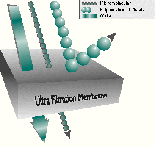

The U.S. Department of Energy's efficient separations and processing crosscutting area is evaluating polymer filtration, a new separation technology developed by Los Alamos National Laboratory to remove valuable or regulated metals from aqueous waste streams. In order to pinpoint these metals, specialized water-soluble polymers are added to contaminated water, where they create a bond with the targeted metals. This bonded complex forms a much larger compound that can then be separated from the waste stream. The technology has succeeded in several demonstrations, one that captured nickel and zinc for reuse, as well as another that removed plutonium and americium for disposal. While minimizing waste volumes, this new process may help companies lower disposal costs and comply with stringent federal discharge regulations.
The key to this new process is a water-soluble chelating
polymer that has at least two sites to bind to a specific metal
ion. LANL Principal Investigator Gordon Jarvinen commented that
by having two or more binding sites, the polymer has the
potential to bind more strongly and more selectively. When
applied to liquid waste, the polymers chemically bind with the
targeted metal ions and form larger compounds. The waste stream
is then forced through an  ultrafiltration membrane, retaining
the larger polymer-metal ion combination while allowing the
smaller water molecules and unbound molecules, or ions, to flow
through freely. Once collected in this concentrated solution, the
metal ions are separated from the polymers by adjusting the pH.
Most commonly, the polymers and water are reused, while the metal
ions are either disposed or recycled.
ultrafiltration membrane, retaining
the larger polymer-metal ion combination while allowing the
smaller water molecules and unbound molecules, or ions, to flow
through freely. Once collected in this concentrated solution, the
metal ions are separated from the polymers by adjusting the pH.
Most commonly, the polymers and water are reused, while the metal
ions are either disposed or recycled.
Jarvinen further explained that precipitation is currently a common method for removing regulated metal ions from aqueous waste waters. By adding sodium hydroxide or another base to raise the pH, metal hydroxides precipitate out of solution. While this process is simple and uses low-cost reagents, it does not completely remove all metal ions, resulting in effluents that may not comply with federal discharge limits. Furthermore, a large volume of waste sludge is produced, since precipitation not only pulls out the targeted metals but also collects other metals, water, and hydroxide. In the past, landfilling the resulting sludge was not very expensive; however, stringent regulations, a diminished number of permitted sites, and industrial liabilities have driven up the cost. LANL's goal is to bring polymer filtration into the separations technology market at a lower overall cost than precipitation methods, Jarvinen said.
Polymer filtration could be a successful, cost-efficient alternative to the precipitation technique. Because of its selectivity, polymer filtration produces a relatively small amount of concentrated metals instead of generating large quantities of sludge. For example, in May 1994 at the Boeing Aerospace Facility in Seattle, DOE contracted LANL to demonstrate the removal of nickel and zinc from waste water generated by electroplating operations. The waste water treatment not only condensed the original 100 gallons to 1.5 gallons of concentrated nickel and zinc ions, but it also resulted in an effluent that met EPA discharge levels. Without producing any sludge, the metal ions were recovered and the polymers were recycled for use in later treatments. Collaborators from LANL and Boeing received a 1995 R&D 100 award for the development of polymer filtration for electroplating applications. (See Initiatives, October 1995.)
In the Plutonium Facility at LANL, the efficient separations and processing focus area funded a test to demonstrate the removal of plutonium and americium from waste waters. Through polymer filtration, the metal ions originally dispersed throughout 7.0 liters were concentrated into 0.25 liters. The metal ions were then cemented for disposal. The alpha activity, a convenient measure of the radioactive metal concentration, in the remaining 6.75 liters of effluent was lowered from 75,400 to 333 counts per minute per milliliter.
After developing polymer filtration, LANL selected Micro-Set, a division of the Polymer Group, Inc., to be its general industrial partner for the commercialization of this technology. Micro-Set is currently developing systems for several firms. Three elements are considered when fitting each company's individual specifications: characterizing the waste stream accurately, matching a polymer to the particular waste stream, and matching the metal removal system to the industrial process stream itself. Micro-Set plans to produce standardized units for the electroplating and metal finishing industry, as well as broaden this technology to include other industrial applications.
![]()